Monuments in Singapore reflect the country’s historical significance and cultural diversity across its compact yet modernised city-state. Singapore is situated in Southeast Asia and is known for maintaining preserved heritage sites alongside contemporary infrastructure. Many structures across the city hold national relevance and honour key events, leaders, or communities of the past. These sites include colonial landmarks, religious buildings, bridges, and war memorials representing different aspects of Singapore’s history.
Top 14 Monuments In Singapore To Visit
Monuments in Singapore provide insights into the country’s political, cultural, and religious heritage. The following list includes significant sites with historical and civic relevance.
1. The Cenotaph
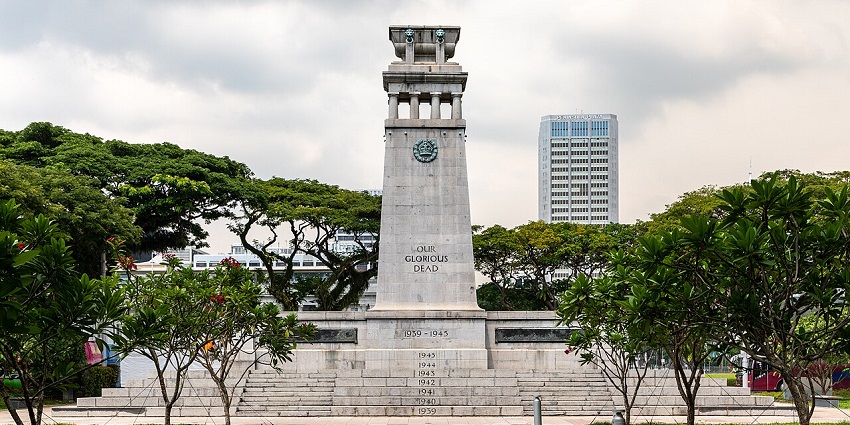
Photo: Dietmar Rabich / Wikimedia Commons
A solemn war memorial with Our Glorious Dead is a prominent monument in Singapore.
The Cenotaph is one of the famous monuments in Singapore, commemorating soldiers who died during World War I and II. Erected in 1922, the monument honours the contributions of British soldiers from Singapore who served in foreign campaigns. Made of granite, it contains inscriptions in English listing the fallen soldiers’ names. Located at Esplanade Park, this structure symbolises national sacrifice and remains a spot for remembrance services. Visitors can find educational plaques that detail Singapore’s colonial military history and wartime experiences.
Major Attractions: War memorials, heritage plaques, peaceful reflection zone
Location: Connaught Dr, Esplanade Park, Singapore
Suggested Read: Hidden Places In Singapore
2. Civilian War Memorial
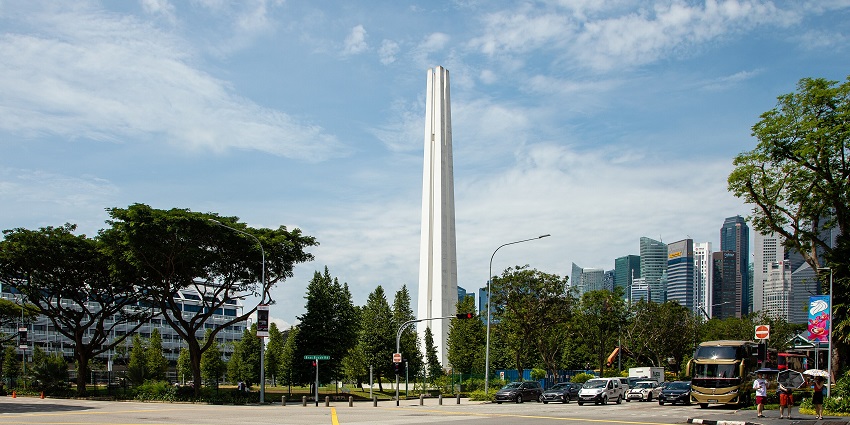
Photo: Bijay Chaurasia / Wikimedia Commons
A tall, white obelisk-style structure in the cloudy sky, an iconic monument in Singapore.
Built in 1967, this site is one of the prominent historical monuments in Singapore, dedicated to civilians killed during the Japanese Occupation. The monument features four identical pillars that represent the shared suffering of Singapore’s four major ethnic groups. It is commonly referred to as “The Chopsticks” by locals due to its design. Managed by the National Heritage Board, the structure is a key site during Total Defence Day events. The site encourages visitors to reflect on the cost of conflict and the importance of unity across communities.
Major Attractions: Ethnic unity symbolism, reflection area
Location: Nicoll Highway, Stamford Rd, &, Singapore
3. Tan Si Chong Su
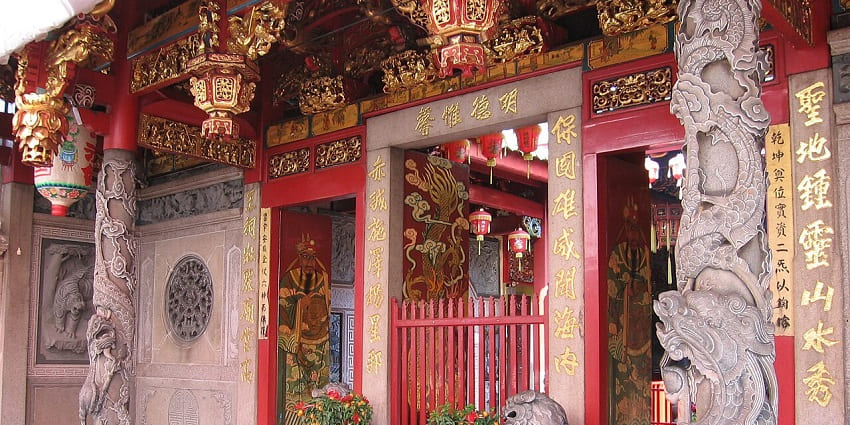
Photo: User:Sengkang / Wikimedia Commons
This is a traditional Chinese temple with green-tiled roofs, one of the best places to visit in Singapore. Established in 1876, it was originally built by the Tan clan in Singapore for ancestral worship and Taoist practices. It holds historical importance as a communal centre for the Tan family members who settled in the city. Architecturally, the building features detailed ceramic figurines and symmetrical layouts influenced by traditional Chinese design. The temple is also noted for its dedication to Kai Zhang Sheng Wang, a revered Chinese deity. It functions both as a place of worship and a cultural reference point for clan associations in the region.
Major Attractions: Temple architecture, ancestral tablets, Taoist altar
Location: 15 Magazine Rd, Singapore
Suggested Read: Temples In China Town Singapore
4. Chesed-El Synagogue
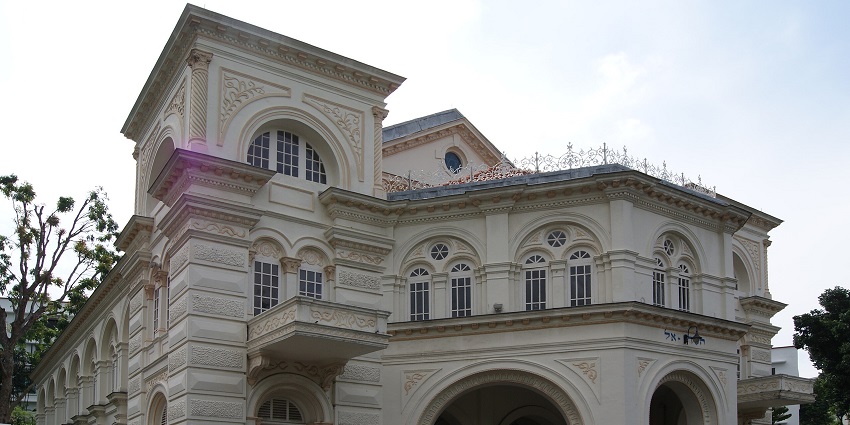
Photo: Smuconlaw / Wikimedia Commons
A grand colonial-style building with windows, one of the oldest monuments in Singapore.
Constructed in 1905, this place of worship reflects the presence of Jewish heritage in Singapore. Designed in a mix of Renaissance and colonial architectural styles, it serves the religious needs of Singapore’s small Jewish community. It continues to be an operational synagogue with historical records and an adjoining community hall. The interior features stained glass, grand columns, and Hebrew inscriptions reflecting its religious function. The synagogue is occasionally opened for educational visits and religious events during Jewish holidays.
Major Attractions: Synagogue structure, heritage-listed design
Location: 2 Oxley Rise, Singapore
5. Cavenagh Bridge
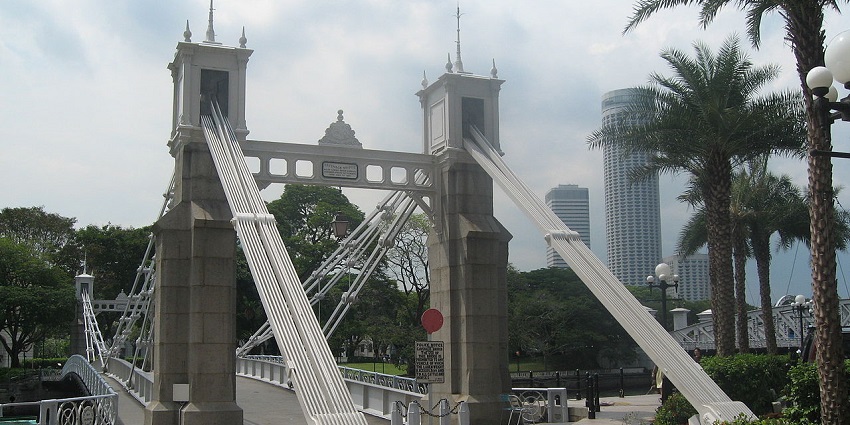
Photo: Terence Ong / Wikimedia Commons
The Cavenagh Bridge, one of the monuments in Singapore, with a distinctive suspension.
Cavenagh Bridge remains an enduring element of 19th-century engineering in Singapore. Originally constructed to handle light traffic, it now functions as a pedestrian-only passage, linking historical and business districts. Visitors notice the decorative metal trusses and detailed lamp posts crafted in Glasgow, still intact today. Educational panels describe their significance during colonial rule, including governance, commerce, and law enforcement. Its preserved signage, restricting vehicle use, stands as a rare remnant of early public regulations. Today, it offers a walking route with heritage value.
Major Attractions: Colonial engineering, riverfront access
Location: 1 Fullerton Square, Singapore
Suggested Read: Historical Places In Singapore That Reflect Its Rich Cultural Legacy And Heritage
6. Maghain Aboth Synagogue
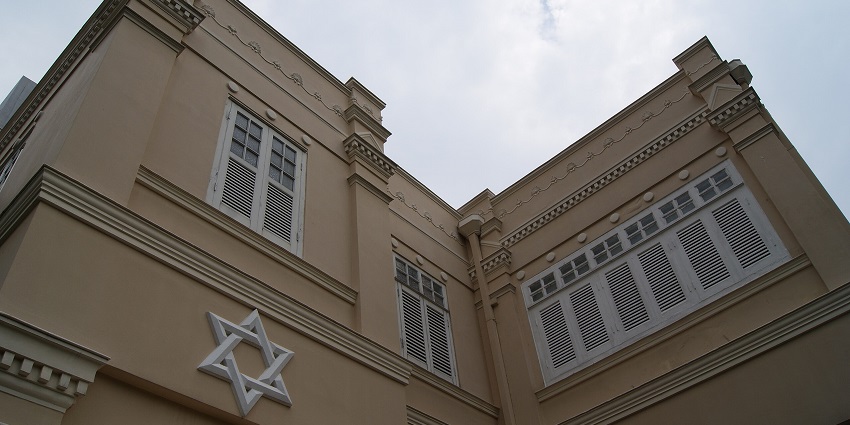
Photo: Smuconlaw / Wikimedia Commons
Maghain Aboth Synagogue stands as a central institution in the Jewish community’s early history, one of the best monuments in Singapore. Built during a period of merchant settlement, its location and structure reflect the needs and values of Jewish traders. Its Neo-Classical architecture, with geometric balance and columned design, aligns with 19th-century stylistic influences. Inside, religious items and layout speak to continued traditions. The synagogue is still active today, offering a place of worship and heritage. The adjacent centre helps preserve stories of migration and cultural life.
Major Attractions: Religious artefacts, symmetrical façade
Location: 24/26 Waterloo St, Singapore
7. Statue Of Raffles
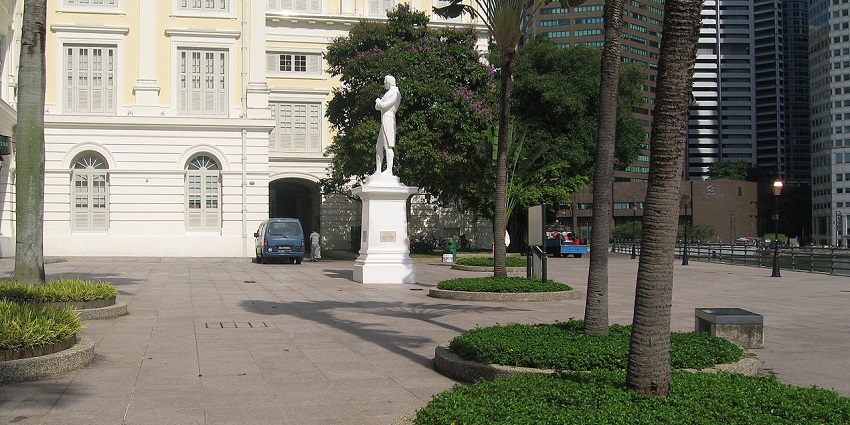
Photo: Terence Ong / Wikimedia Commons
A white statue of Sir Stamford Raffles with arms crossed, standing on a pedestal.
The Statue of Raffles draws attention to a turning point in Singapore’s colonial development. Strategically placed along the Singapore River, it serves as a symbolic reminder of Sir Stamford Raffles’ arrival. The statue’s white finish and stance contrast with the surrounding structures, prompting reflection on British policies. Visitors explore nearby plaques detailing colonial trade and administration. It’s often used in school excursions and heritage walks focused on early governance. While Raffles remains a debated figure, the statue sparks ongoing discussion on history.
Major Attractions: Historical markers, riverside views
Location: North Bank, Singapore
Suggested Read: Places To Visit In Singapore With Family For A Memorable Experience
8. Ho Chi Minh Monument
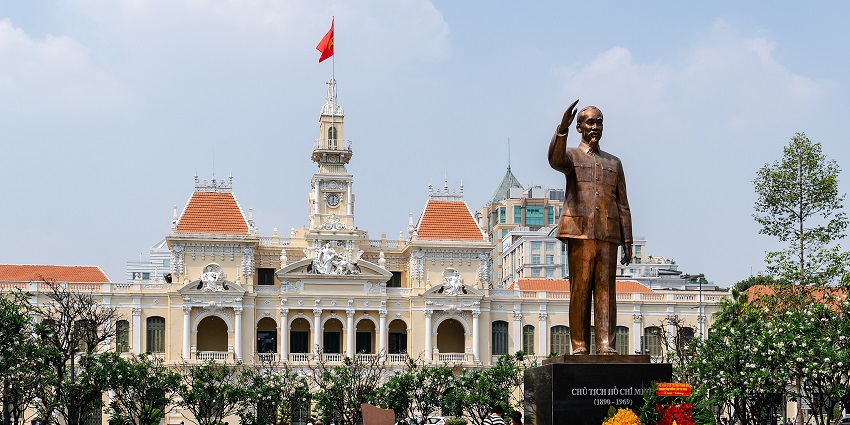
Photo: Steffen Schmitz / Wikimedia Commons
A large bronze statue of Ho Chi Minh gestures, is one of the monuments in Singapore.
This monument honours Ho Chi Minh’s influence on regional diplomacy and represents Singapore’s recognition of international leaders. Installed in a quiet park, it reflects political respect and shared historical ties with Vietnam. Designed, the sculpture encourages students and researchers to examine Southeast Asian diplomatic history. His brief stay in Singapore during the 1930s is commemorated through multilingual information panels. The monument is a meeting point for educational tours, often used in courses exploring global leadership and transnational exchanges.
Major Attractions: Historical plaques, international diplomacy theme
Location: 1 Empress Pl, Singapore
9. Sri Srinivasa Perumal Temple
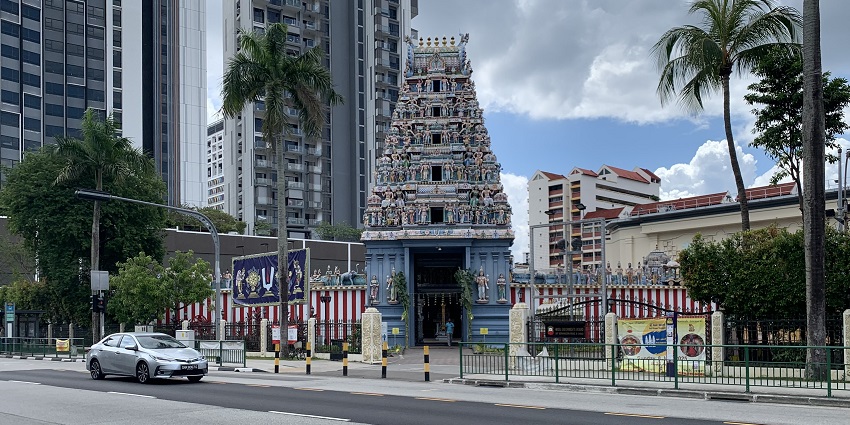
Photo: Chainwit./ Wikimedia Commons
The tower of the temple is adorned with statues of deities and mythological figures.
Sri Srinivasa Perumal Temple offers insights into the spiritual traditions brought by Indian migrants. Its detailed tower, depicting mythological events, introduces visitors to classical stories from Hindu scripture. Devotees participate in regular rituals, which offer opportunities to observe prayer, music, and traditional offerings. During Thaipusam, the temple becomes a central route for religious observance, drawing large gatherings. Architectural details reflect Dravidian influence, from column patterns to sculptural narratives. Beyond its religious function, it plays a role in preserving customs passed through generations.
Major Attractions: Gopuram, cultural festivals, religious ceremonies
Location: 397 Serangoon Rd, Singapore
Suggested Read: Temples In Singapore
10. Chinese High School Clock Tower Building
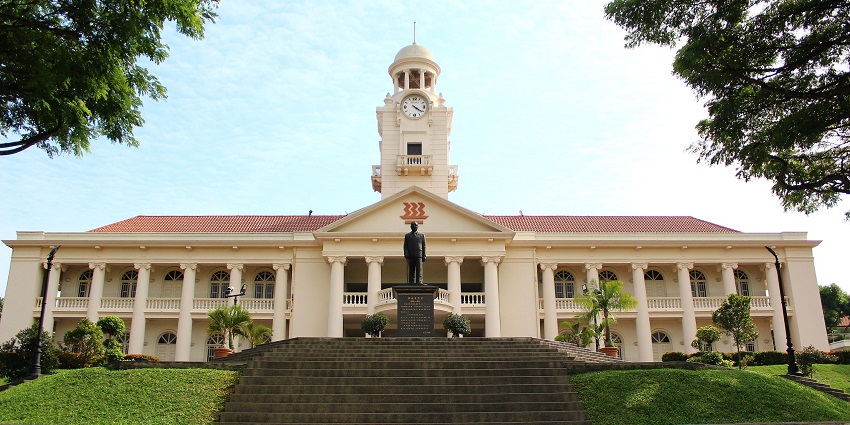
Photo: Quince Pan / Wikimedia Commons
A grand colonial-style building with a clock tower and a statue in front, Singapore.
The Chinese High School Clock Tower is closely associated with academic determination and resistance during critical times. Initially part of a pioneering institution for Chinese education, it served as a central location for announcements and gatherings. Students and staff once used it as a reference point during wartime emergencies and school ceremonies. Its Art Deco architecture symbolises a modern approach in early 20th-century school design. Now protected as a national monument, it continues to represent educational commitment and cultural identity through its preserved form.
Major Attractions: Clock tower, historical archives
Location: 661 Bukit Timah Rd, Singapore
11. Fort Siloso
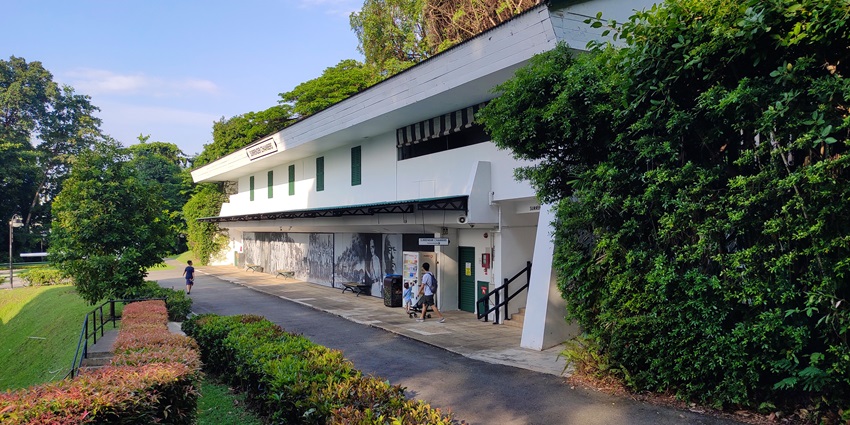
Photo: Moheen Reeyad / Wikimedia Commons
Fort Siloso, perched on Sentosa Island, is Singapore’s only preserved coastal fort and a living reminder of its military past. Constructed in 1878, it was once part of a formidable chain of defences guarding Keppel Harbour and played a crucial role during World War II. Visitors now explore maze-like tunnels, restored gun batteries, and lifelike wax dioramas that evoke the drama of wartime surrenders and coastal battles. The fort’s verdant surrounds and panoramic sea views make history tangible for all ages, one of the best among Singapore monuments.
Major Attractions: Surrender chambers, Fort Siloso skywalk, coastal gun emplacements
Location: Siloso Rd, Singapore
Suggested Read: Places To Visit In Sentosa Island
12. National Museum Of Singapore
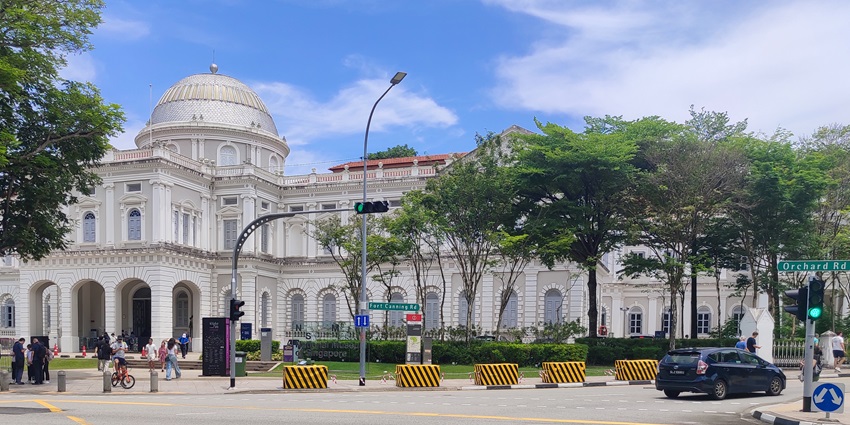
Photo: Moheen Reeyad / Wikimedia Commons
Singapore’s oldest museum, the National Museum of Singapore, masterfully blends classical 19th-century architecture with sleek modern galleries. Exhibits here delve into everything from local history and independence to contemporary art installations. Interactive showcases and dynamic storytelling bring the nation’s evolving identity to life, welcoming visitors into immersive journeys through time. Its lush green entrance, iconic dome, and cultural programming, including festivals, workshops, and film screenings, make it a hub for learning and inspiration. Whether you’re a history buff or a curious tourist, this institution promises enlightening encounters with the heritage and some of the best things to do in Singapore.
Major Attractions: History gallery, Story of the Forest, Goh Seng Choo gallery
Location: 93 Stamford Rd, Singapore
13. Former House Of Tan Teng Niah
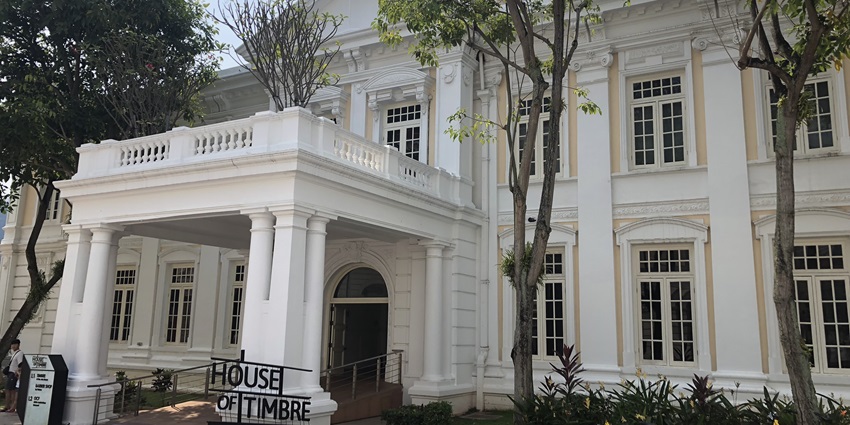
Photo: Bjoertvedt / Wikimedia Commons / Image For Representation Only
The Former House of Tan Teng Niah radiates colour and character in Little India, standing out as the last surviving Chinese villa in the area. Built in 1900, its ornate facade bursts with rainbow hues, a tribute to Singapore’s multicultural aspect. The restored shophouse, once the residence of a prominent businessman, attracts photographers and culture lovers with its eye-catching details and storied halls. Wandering past its striking exterior and tucked-away rooms, visitors can appreciate a blend of architectural heritage and communal spirit in this lively historic corner.
Major Attractions: Gilded name plaque, five-foot way structure, restored pintu pagar carvings
Location: 37 Kerbau Rd, Singapore
Suggested Read: Places To Visit Near Singapore For The Ultimate Holiday
14. Lee Kong Chian Natural History Museum
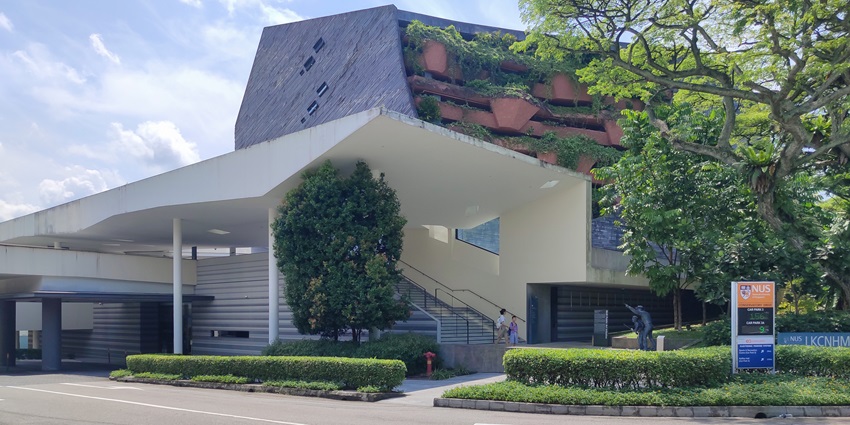
Photo: Moheen Reeyad / Wikimedia Commons
Perfect for curious minds, the Lee Kong Chian Natural History Museum celebrates Singapore’s biodiversity with engaging flair. Modern yet inviting, this museum showcases thousands of plant and animal specimens, including impressive dinosaur skeletons. Interactive displays, lush green surroundings, and striking architecture foster an appreciation for natural science and conservation. Children and adults marvel at Singapore’s ecological treasures, from marine wonders to rainforest giants. With educational programs and research spaces, the museum inspires new respect for the city’s flora, fauna, and geological riches.
Major Attractions: Dinosaur zone, heritage gallery, marine biodiversity exhibits
Location: 2 Conservatory Dr, Singapore
Monuments in Singapore reflect the nation’s diverse cultural roots, historical transitions, and long-standing traditions. From sacred temples to colonial-era memorials, these structures highlight different periods that shaped the island’s identity. Each site reveals how various communities have contributed to Singapore’s social fabric over time. Let TripXL guide you through Singapore’s rich past with curated visits to locations that hold significant meaning for residents and visitors.
Cover Photo: Basile Morin / Wikimedia Commons


 WhatsApp
WhatsApp
 Twitter
Twitter









